Commemorative Quilt
The Library

In the early 1960's, a controversy arose as to whether or not the Borough needed its own library. Mayor Charles Judson appointed a committee to investigate whether the Borough needed its own library or whether the Borough should continue to utilize the services of the Bound Brook library. This Committee recommended that the Borough should have its own library and Mayor Judson and the Borough Council then created the Library Board of Trustees . The Beard of Trustees appointed a Librarian and this resulted in the formation of a small library which operated out of a store front on Route 28, which then expanded to a building once known as "The Palmer House", which was located on a portion of the property now used by the High School. As circulation of books increased, the Library Board of Trustees realized that the rough needed its own library building and the present building was constructed in December of 1970. The library recently completed an expansion and is now providing all kinds of different services to the general public ranging from books to tapes to videos to Internet services.
Square by Marian Rodzinak
The American Flag

The first unofficial national flag, called the Grand Union flag or the Continental Colors, was raised at the behest of George Washington near his headquarters outside of Boston, Massachusetts on January 1, 1776. According to popular legend, the first American flag was made by Betsy Ross, a Philadelphia seamstress. Supposedly, General Washington and two representatives from the Continental Congress visited Ross at her upholstery shop and showed her a rough design of the flag. Although Washington initially favored using a star with six points, Ross argued for a five pointed star, which could be cut with just one quick snip of the scissors. The original American flag contained 13 stars and 13 alternating red and white horizontal stripes and represented the original 13 Colonies and the flag symbolized national unity and also reflected the common feeling at that time that such a symbol was necessary. After much experimentation (one version pictured the Union as a snake made up of 13 segments) the Continental Congress adopted the first official national flag, also known as the stars and stripes, in June of 1777. Although nobody knows who designed the flag, it may have been Continental Congress member Francis Hopkinson. After Vermont and Kentucky were admitted to the Union in 1791 and 1792 respectively, two more stars and two more stripes were added in 1795. This 15 star, 15 stripe flag was the "star-spangled banner" that inspired Francis Scott key to write the poem that later became the national anthem. In 1818, after 5 more states had gained admittance, Congress passed a law fixing the number of stripes at 13 and requiring that the number of stars equal the number of states. The last new star, bringing the total to .50, was added on July 4, 1960, after Hawaii became a state. Today, the original flag adopted by the Continental Congress still flies over the Bound Brook campgrounds where George Washington camped with his army during the Revolutionary War.
Square by Jean Ross
The Lincoln Statue
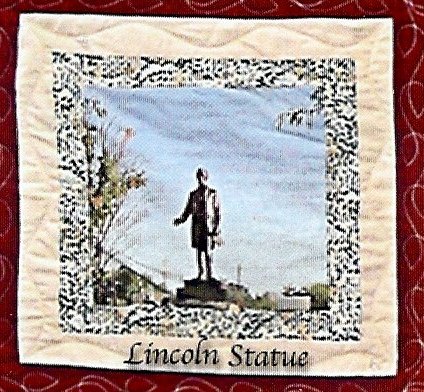
On May 30, 1898, while this country was still engaged in the Spanish-American war, which did not end until August of that year and which resulted in Spain losing its colonies in the American continent (Cuba and Puerto Rico) and losing its South Pacific territories (the Philippines) and at a time when the United States provided for the annexation of the Hawaiian islands to the United States, the statue of Abraham Lincoln was erected in the old railroad plaza at the corner of Lincoln Boulevard and Mountain Avenue. Silas Dewey Drake, one of the forefathers of Middlesex, commissioned Alphonse Pelzer, a German immigrant, to create the statue. Pelzer employed a technique similar to the one used by the French on the Statue of Liberty. The bronze-like copper model statue stands 7 feet tall on 13 inch feet. It cost Mr. Drake $700.00 to purchase this statue from the W.H. Mullis Architectural Co., with a sales office located on Chambers Street in New York City and its main manufacturing office located in Salem, Ohio. Mr. Drake was the president and manager of the New Jersey Mutual Realty Company and a developer of land in the Borough and he wanted a statue of Lincoln to be located in the section of Middlesex that he was developing at that time, which he called "Lincoln".
Square by Betty Comune
Victor Crowell Park Boathouse
The stone boathouse is a landmark to this day in Victor Crowell Park. The building served as a meeting place for residents during winter days when ice skating and sleigh riding on the lake were popular pastimes. The boathouse stands as the centerpiece in the redeveloped park today. Victor Crowell Park was originally known as Willow Park and was built in the 1930's as part of President Franklin Delano Roosevelt's Work Progress Administration projects. The park was named after Victor Crowell, a resident and West Point graduate who was killed in World War II. The park is still today a haven for those residents seeking a place to get away from the hustle and bustle of everyday life.
Square by Mary Diskin
The Middlesex Fire Department
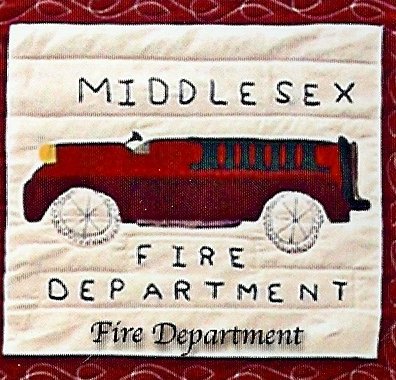
The Middlesex Fire Department marked its 100th anniversary in 2005. Middlesex Borough inherited its fire department from the Piscataway Fire Department. In 1905 the men or the Lincoln section of Piscataway organized a volunteer fire company which, in turn, would become part of the first fire protectors of Middlesex Borough which became a town of its own in 1913. The Lincoln Hose Company was followed by the formation of the Beechwood Heights Fire Company in 1908, the H. C. Pierce Hose Company also in 1908 and the Parker Engine and Hose Company in 1921. The 100 year plus history of the Middlesex Fire Department is the story of the development, challenges and progress started by its founders and carried on by its truly dedicated leaders and department members throughout the years. It is the history of proud service to our community by our fire fighters who place their lives on the line on a daily basis for the security and well being of Middlesex Borough residents and town, business and personal property.
Square by Betty Kellijs
The Seal of The Borough of Middlesex

The design of the Seal of the Borough of Middlesex represents three features of the development and settlement of our community. The three features set off in adjoining triangles are the wheels and torch symbolizing our industry, the arrowhead and canon symbolizing our history and the three houses symbolizing our residential characteristics. Our Borough name, our county name and the name of our State stand out prominently on the seal as well as the year, 1913, when Middlesex broke away from Piscataway and became a town of its own.
Square by Jacque Sebens
The Knickerbocker Toy Company
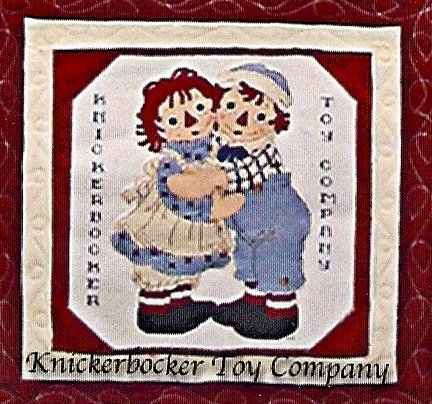
The world famous Raggedy Ann and Raggedy Andy dolls were first created in 1914. Raggedy Ann and Raggedy Andy were manufactured by the Knickerbocker Toy Company, located off Runyon Avenue in Middlesex, between 1962 and 1982. The toy company provided many employment opportunities for our local residents. Known for their red striped stockings, red hair, big grins, and hearts hearing the words "I love you" the two dolls brought great pleasure to young children and today are collectibles in the adult world.
Square by Jennifer Emrich
Map of the Borough of Middlesex

Middlesex Borough consists of an area of four square miles. It is located in the northwest corner of Middlesex County and portions of the town border the Somerset County communities of Bridgewater, Bound Brook and Green Brook. The eastern section of Middlesex is in close proximity to Union County. Middlesex is bounded by Bridgewater on the northwest, Green Brook on the north, Piscataway on the south, Bound Brook on the west and Dunellen on the east. A number of highways serve the area of Middlesex Borough. U.S. Highway 22 is located just north of the Borough and State highway 28 runs through the town from east to west and State Highway 18 and Interstate highway 287 are in close proximity to the Borough.
Square by Mary Diskin
Zip Code - 08846

Just as numbers have superseded people in our Society today, they have also superseded places. John Jones is now SSN 156-20-2202 (fictitious name and number being used for illustration purposes only) and the Borough of Middlesex is now 08846. Ever since the U.S. Post Office devised the numerical code to aid in the distribution of U.S. mail, Middlesex, New Jersey has become 08846.
Square by Niki Gerondelis
Houses of Worship
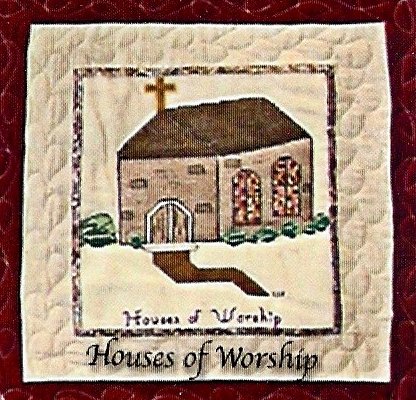
At the present time the Houses of Worship in Middlesex include the Middlesex Bible Chapel, the Middlesex Presbyterian Church, The Kingdom Hall of Jehovah's Witnesses, the Reorganized Church of Jesus Christ of Latter Day Saints, Our Lady of Mount Virgin Roman Catholic Church, the Christian Life Church and the Meetinghouse of the Freedom in Christ Baptist church. The Middlesex Bible Chapel, the original Protestant church in the borough, initiated its Sunday School on February 12, 1928. In 1936 a partially completed building was dedicated and then completed in 1937. Today the congregation still meets in the original church at 100 Fairfield Avenue. In October of 1961, the Presbytery of Elizabeth voted to organize a Presbyterian Church in Middlesex. Groundbreaking for the new church was held on July 4, 1965, and the first service was held on Christmas Sunday of that year. The Kingdom Hall of Jehovah's Witnesses was built in 1959 on the corner of William Street and Blackford Avenue, near the Piscataway Township boundary line. The first presiding minister was Charles W. Erlenmeyer. The Reorganized Church of Jesus Christ of Latter Day Saints has occupied its church at the corner of Howard and Union Avenues for the past thirty years. The Church has changed its name to the Community of Christ - Middlesex Congregation. The original Our Lady of Mount Virgin Roman Catholic Church was constructed in 1925 on land donated by the James Curcio family. Our Lady of Mt. Virgin became a parish in 1943. The local Catholic school was built in 1955. The present church was built in 1971. The Christian Life Church is located on the southerly side of Lincoln Boulevard east of the Pathmark Supermarket. The Meetinghouse of the Freedom in Christ Baptist Church is located on the southeast corner of Bound Brook Road and Smalley Avenue at the Dunellen-Middlesex boundary line.
Square by Catherine Ferris and artwork by Lyndsey Johnson
Flowertown
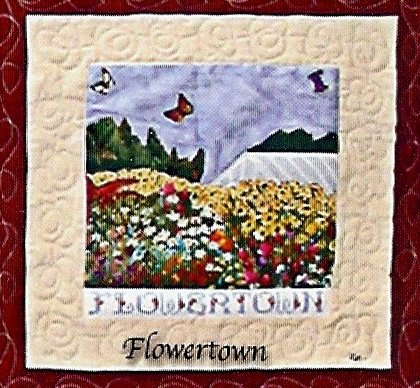
Middlesex Borough was famous for its nurseries and greenhouses and it was said that nowhere in the area was there soil as rich as that which had been washed down and accumulated at the foot of the Watchung mountains. At one time, there were more nurseries and greenhouses per square mile in Middlesex than in any other town in New Jersey and, because of that fact, during the 1950's and 1960's, the town was often referred to as "Flowertown, U.S.A.". As land became more valuable and housing needs became more pressing in Middlesex, as in most other areas of this country, most of the land that had been reserved and used for agricultural purposes was sold and developed for housing and today, there are only a few greenhouses left to remind people of the heyday of "Flowertown" in the Borough. Their existence is severely threatened by the tremendous increase in the cost of fuel to heat the greenhouses, since the cost to produce the plants is now almost more than the growers can obtain from the sale of the plants.
Square by Cathy Canavan
The Old Borough Hall
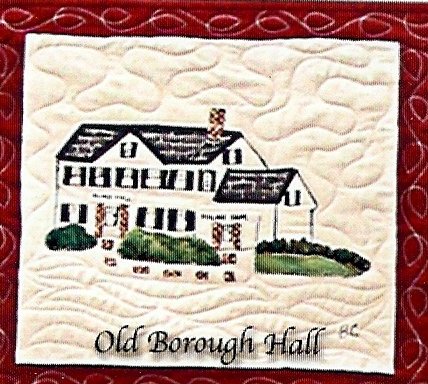
Middlesex Borough, like many of the old towns in New Jersey, adopted one of the graceful mansions that were built in the early part of the 19& century as its Borough Hall in 1948 and used the building until October of 1962, when the present Municipal building was constructed. The stately styled white home with twin pillars at the front entrance and shutters decorating the front windows which was set back on a perfectly manicured front lawn and flanked by graceful trees was originally the home of the Conover family and was located at the corner of North Lincoln Avenue and Bound Brook Road (Route 28). In the early days of Middlesex, the town was divided into sections referred to as Conover's corner, Morecraft's corner, Giles Corner, Mannion's corner and the Colonial House corner.
Square by Betty Comune
Pathe-Freres
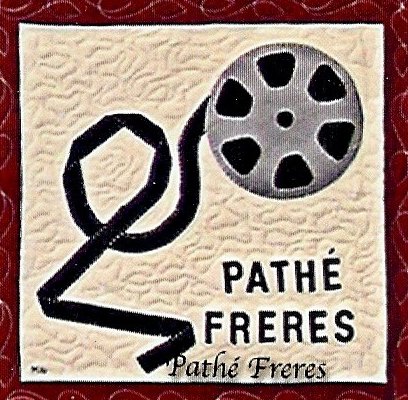
The Pathe Moving Picture Company, officially known as Pathe-Freres Moving Pictures, operated for many years on Lincoln Boulevard. The company produced many full length movies during the 1930's and, during the World War II, it was famous for its newsreels, which were introduced by a crowing rooster and which featured the mellifluous voice of Lowell Thomas keeping people informed of developments in Europe and Japan. The Company still exists today and is still producing major full length films. Many of the company's historic films were stored in specially constructed bunkers located on the Middlesex property during the mid century until better storage methods were discovered for preserving the films.
Square by Mary Ann Gazi
The First Pierce School

The original Pierce School was built in 1902 as a one-room school house on Drake Avenue. It relocated to Raritan Avenue and was also known as the East Bound Brook School House. It was built on land donated by Mr., Hugh Pierce, who developed the section of town adjacent to Bound Brook often referred to as East Bound Brook The building was condemned as a fire hazard in 1920. Pictured here on the quilt is the last Pierce School which was built in 1920-21 at a cost of $118,000.00, including land on the location at Walnut Street. The building was closed in 1983 and demolished in 1984. The different Pierce schools were the educational homes for thousands of elementary students for almost eight decades and the Pierce school pictured on this quilt was replaced by a small housing development.
Square by Rita Lopa
The Middlesex Blue Jay

The royal blue and white were chosen as the school colors for the brand new Middlesex High School in 1959. The colors were first announced at a combined meeting of the Junior High and Senior High School boards at Central School which is now Von E. Mauger School. The school colors were chosen by the pupils at Central School and the Freshman class members of the Bound Brook High School who were residents of Middlesex and who would now be going to their own high school in their town. Prior to 1959, Middlesex students of the public high school age group, attended Bound Brook High School. The Blue Jay, the symbol and mascot of Middlesex High School, was the choice of its first administration, Principal Roland Lindwald and Assistant Principal Ruth Hueston. The two administrators selected the Blue Jay because of its scrappy and feisty ways. Middlesex High School today is known as the home of "The Fighting Jays" or "The Fighting Bluejays".
Square by Betty Kellijs
The Union Trolley Line
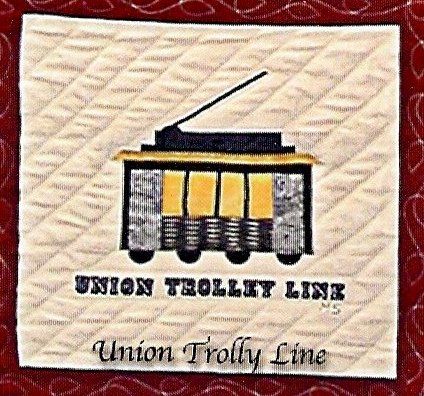
The first trolley line in Middlesex Borough was constructed at the beginning of the 20th century. In 1895, the Brunswick Traction Company obtained a franchise to lay track through Bound Brook, what is now Middlesex, Piscataway and Dunellen to the Plainfield city line. The transition from horse-drawn conveyances on muddy roads to electric cars on rails occurred at this time. The trolley had its turntable located in Bound Brook and proceeded from East Street, along Beechwood Avenue to Harris Avenue, along Harris Avenue to South Lincoln Avenue, along South Lincoln Avenue to Route 28 and from Route 28 to Dunellen and on to Plainfield.
Square by Marie Sabecky
The Middlesex Borough Police Department

William Fellows was the first police chief in Middlesex. (1933-1935). He was followed in that office by Gordon Fuller (1939-1963), who was chief of police in the Borough when the Borough had its police headquarters located on Bound Brook near its intersection with Mountain Avenue. He was succeeded in office by Andrew Simpf, who sewed in that capacity from 1963 to 1981. The current police department has an authorized strength of 32 persons, including Chief James Benson. The police department will be getting a new police headquarters building to be located on Mountain-Avenue, adjacent to the Middlesex Borough Senior Citizens housing complex, which should be ready for occupancy by sometime in 2007.
Square by Betty Comune
Middlesex's First School Bus
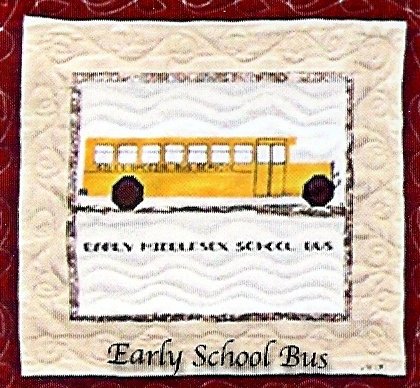
When Middlesex was first established as a Borough in 1913, schoolchildren either walked or were driven by horse drawn carriages to the old Pierce School on Chestnut street (erected in 1902 as a two-story, 4 classroom building which was a departure from the usual one room schoolhouse and which was named in honor of Dr. Hugh C. Pierce who donated the land for the school or to the Harris Lane schoolhouse (the old fashioned one room schoolhouse) it the corner of Union Avenue and Harris Avenue. As time passed, however, Middlesex joined the 20th century and three school buses were purchased and operated by Giles Special Bus Service. Charles Giles was the first school bus driver and the buses were parked at the Giles property on Harris Avenue. The Giles family was one of the earliest families in the Borough and as the Borough developed, so did the Giles family- later graduating from operating school buses to operating a cross-country trucking company. Middlesex Borough resembled the plains of Kansas in the early 1900's with very few homes and large areas of grass and fields throughout the Borough. The roads were mostly dirt paths and the "Road Grader" was a common sight as it made its way along the roads distributing the dirt so it would cover over holes that developed and so that it would grade the road so the water would not lay in pools on the roadway surface. Does anyone remember the "Road Grader"? School buses have not changed much in appearance over the years as you notice from comparing the school bus pictured here with today's version.
Square by Marion Oliver and artwork by Robert Emrich
The Foothill Playhouse
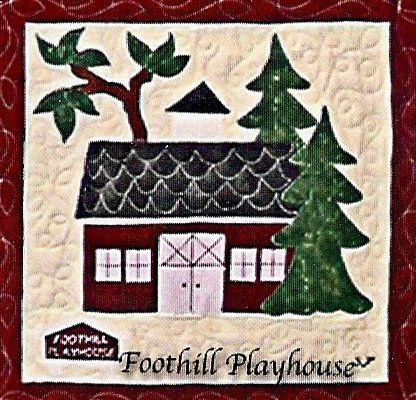
The Foothill Playhouse, New Jersey's summer theatre in a barn, was located near the northerly end of Beechwood Avenue. The Foothill players were organized by Charlotte and Stanley Klein on June 7, 1947. The players first performed in a playhouse on Route #29 (now Route #22) which burned to the ground in 1929. The Foothill Players were given the use of the barn on Beechwood Avenue in 1951. The barn was converted into a 176 seat theatre in 1952. The actors performed for free. The hayloft became the balcony. The patio was once a creaky, over-hanging shed. The main curtain was a hand sewn crazy quilt. The cow stalls became tiny dressing rooms. The milk shed became the actor's lounge. Refreshments were served in the old corral and cowbells were used to signal curtain time. This barn was now their permanent home. Trudi Suabedessen was the choreographer for the company and directed most of the dance scenes and reproductions. The Kleins were the founders and operators of the playhouse and directed many of the shows produced by the company. They staged musical comedies, dramatic productions and most of the Broadway productions of the time in their intimate little theatre.
Square by Shirley Fisher
The Middlesex Freight and Passenger Station
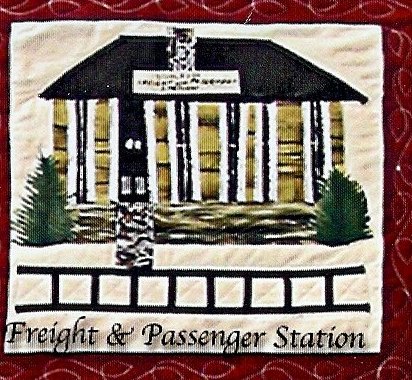
The Middlesex Freight and Passenger Station was located on Lincoln Boulevard near the statue of Abraham Lincoln. In earlier days, the building served as the Central Railroad of New Jersey station and was part of the railroad plaza when spectators watched the unveiling of the Lincoln statue in 1898. Middlesex residents and people from neighboring communities utilized the station for years for train transportation to New York City and back to Middlesex. In addition, freight was unloaded at the station as well as mail and was then transported by truck to ultimate destinations. Passenger and freight service at this station ended in the early 1950's but the present Middlesex Borough Governing Body is attempting to convince the New Jersey Department of Transportation to build a new station at this location to service the increasing needs of the traveling public.
Square by Marion Rodzinak
The Staffelli Diner
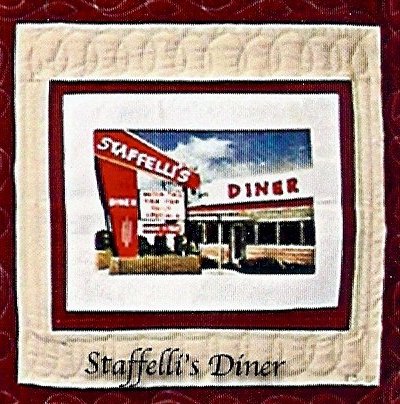
Good food at reasonable prices. New Jersey is famous for its "diners", and these eateries are unique to this area. Where else can you go for food where the menus are several pages long and you can order anything from fruit to nuts and expect to get it. Breakfast, lunch and dinner are all gastronomical treats at these establishments. Most restaurants specialize in one type of food or another but at a diner, you can get anything. The Staffelli diner was typical of this breed of restaurant. Proprietor and owner Lou Staffelli, a wearer of many hats, (former Mayor of Middlesex, Middlesex County Republican County Chairman) prepared delicious home-made soups and "specials" such as meatloaf, pot roast, lasagna and other delicacies every day and his bread pudding and tapioca puddings were legendary. The diner was built by Mahoney Dining Car Co. of Elizabeth, N.J. in 1947 and was moved by trucks to its first location at the corner of Union Avenue and Vosseller in Bound Brook and was operated under the name of "Middlebrook Diner". The diner was moved to 1316 Bound Brook Road in Middlesex near the present location of the post office in 1961 and was renamed, "Staffelli's Diner", where it remained until it closed for business in the mid 1960's.
Square by Edythe Staffelli & Edith Fritzinger
Thomas Young Orchids

Thomas Young Orchids located on Harris Avenue one block south of Route 28 was one of the most famous hybrid-orchard producers in the United States during the 1900's, sending orchids all over the Unites States. Eleanor Roosevelt ordered specially from this company, which obtained world renowned fame for the excellence of their orchids. This company helped spawn the Giles Express Trucking Company in Middlesex, which shipped the orchids all over the eastern seaboard and to the Midwest to Chicago and other such destinations and was one of the earliest trucking companies in this country to engage in interstate commerce. Thomas Young Orchids was also partially responsible for the development of some of the first refrigerated trucks used in this country, since it was necessary to maintain a cool climate when shipping the flowers to insure that they did not die during shipment. A housing development now occupies the land where the greenhouses previously flourished.
Square by Mary L. Johnson and Artwork by Lyndsey Johnson
Middlesex 50th Anniversary
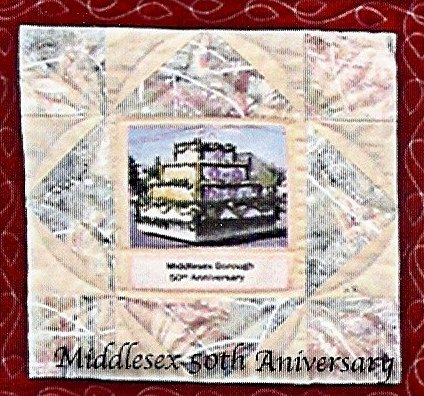
The year 1963 was the 50th anniversary year of the founding of Middlesex Borough. In 1913, Middlesex broke away from the neighboring Piscataway and became a separate town through the actions of the state legislature and local referendum. The Golden anniversary parade was held in the summer of 1963. The parade was known as the Flowertown parade because Middlesex was known as Flower Town because of the number of nurseries and greenhouses in the community. It was said that nowhere in the area was there soil as rich as that which had washed down and accumulated through the years on Middlesex at the foot of the Watchung Mountains. Community leaders worked long and hard to formulate plans for a parade and festivities that would honor a thriving community forged by courage and conflict. At the time of the parade, Jasper Correnti served as Mayor, Andy Simpf was the Chief of Police and Marty Matuskiewicz was the Fire Chief. Show business personality, "The Incomparable Hildegarde Neff", attended the festivities. The old Borough Hall located on Bound Brook Road at the time was beautifully decorated for the occasion. The Middlesex Fire Department, Rescue Squad and other emergency units were active participants in the parade as were their counterparts from throughout the state. It was a gala celebration.
Square by Karen Kranz
The Middlesex Shopping Center

The largest shopping center in our town of Middlesex was first under construction in the mid 1950's. The A & P Supermarket which anchored the westerly side of the shopping center was built in 1957. The other stores that formed the origin Middlesex Shopping Center on Route 28 opposite Greenbrook Road were the W.T. Grant Company and later Shepherd's, which anchored the easterly side of the center. The smaller stores in the center area of the shopping center served a variety of needs for our local residents and included a barbershop, a beauty shop, a liquor store, a florist shop, a jewelry store, a men's clothing store, a woman's fine fashion store, a shoe store, a Hallmark greeting card store , a pizzeria, and a precious gem store. Prior to the construction of the shopping center, the property housed a baseball field and the Sportsmen's tavern.
Square by Rita Lopa
Middlesex Boro Rescue Squad, Inc.
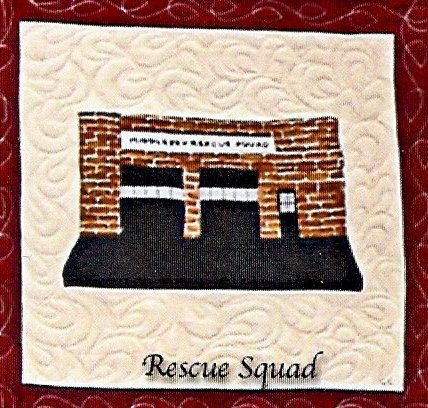
The Middlesex Borough Rescue Squad was first organized in 1941 by Harold Little and Herbert Clausen at a time when the Borough had a population of approximately 3,760 residents. The original squad had a total of 11 members and held its first meeting on March 27, 1941 at the Beechwood Fire House. The present squad building located at the corner of Mountain Avenue and Route 28 was built in 1952 and the front portion of the building is used to house the equipment of the squad and the rear portion of the building is rented out to the Borough of Middlesex which uses it for its senior citizen headquarters. It is believed that the Middlesex Rescue squad was the first squad in the state to have women volunteers. At the present time, the squad has 35 members, a Rescue crash truck and an ambulance and the squad members are all unpaid volunteers who donate their time, service and experience to the Borough at no charge. They respond to calls at all hours of the day and night, provide transportation to and from local hospitals, provide emergency care for accident victims, provide emergency care for sick and infirm residents and many of the volunteers are trained Emergency Medical Technicians.
Square by Cathy Canavan
